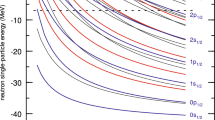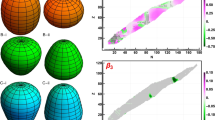Abstract
The structure of neutron-rich nuclei in several isotopes is investigated by shell model calculations. We study the electric dipole (E1) transitions in C isotopes focusing on the interplay between the low-energy Pigmy strength and the giant dipole resonance (GDR). Reasonable agreement is obtained with available experimental data for the photoreaction cross sections in 12C, 13C, and 14C with the inclusion of the quenching effects. A low-energy peak in the dipole strength in 15C is associated with a single-particle motion of the 1s 1/2 valence neutron relative to the 14C core. The calculated transition strength below the GDR in C isotopes heavier than 15C is found to exhaust about 50–80% of the cluster sum rule value and 12–16% of the classical Thomas-Reiche-Kuhn sum rule value. Next, we point out that the quadrupole and magnetic moments in the odd C isotopes strongly depend on configuration, which will be useful to determine the spin parities and the deformations of the ground states of these nuclei. The electric quadrupole (E2) transitions in even C isotopes are also studied. The isotopic dependence of the E2 transition strength is found to be reasonably well explained, although the calculated strength largely overestimates the unexpectedly small strength observed in 16C. The E1 strength in 18N and 19N as well as in Ne isotopes is also investigated.
Similar content being viewed by others
References
H. Sagawa and T. Suzuki, Phys. Rev. C 59, 3116 (1999).
Y. Alhassid, M. Gai, and G. F. Bertsch, Phys. Rev. Lett. 49, 1482 (1982); H. Sagawa and M. Honma, Phys. Lett. B 251, 17 (1990).
A. Leistenschneider et al., Phys. Rev. Lett. 86, 5442 (2001).
E. K. Warburton and B. A. Brown, Phys. Rev. C 46, 923 (1992); B. A. Brown, A. Etchegoyen, and W. D. M. Rae, OXBASH, Oxford, Buenos-Aires, Michigan State, Shell Model Program, MSU-NSCL, Report No. 524 (1986).
T. Suzuki, H. Sagawa, and K. Hagino, Phys. Rev. C 68, 014317 (2003).
D. J. McLean, M. N. Thompson, D. Zubanov, et al., Phys. Rev. C 44, 1137 (1991).
J. Ahrens, H. Borchert, K. H. Czock, et al., Nucl. Phys. A 251, 479 (1975).
H. Sagawa and K. Asahi, Phys. Rev. C 63, 064310 (2001).
Table of Isotopes, Ed. by R. B. Firestone et al. (Wiley, New York, 1996).
T. Suzuki, H. Sagawa, and K. Hagino, in Proceedings of the International Symposium on Frontiers of Collective Motions (CM2002) (in press); H. Sagawa, T. Suzuki, and K. Hagino, Nucl. Phys. A 722, 183 (2003).
H. Ogawa et al., Eur. Phys. J. A 13, 81 (2002).
D. Bazin et al., Phys. Rev. C 57, 2156 (1998); T. Nakamura et al., Phys. Rev. Lett. 83, 1112 (1999); V. Maddalena et al., Phys. Rev. C 63, 024613 (2001).
Rituparna Kanungo, I. Tanihata, Y. Ogawa, et al., Nucl. Phys. A 677, 171 (2000).
K. Matsuta et al., Nucl. Phys. A 588, 153c (1995).
P. Raghaven, At. Data Nucl. Data Tables 42, 189 (1989).
K. Asahi et al., AIP Conf. Proc. 570, 109 (2001).
S. Raman et al., At. Data Nucl. Data Tables 36, 1 (1987).
N. Imai et al., Phys. Rev. Lett. 92, 062501 (2004).
Y. Kanada-En’yo and H. Horiuchi, Prog. Theor. Phys. Suppl. 142, 205 (2001).
P.-G. Reinhard, D. J. Dean, W. Nazarewicz, et al., Phys. Rev. C 60, 014316 (1999).
Author information
Authors and Affiliations
Additional information
From Yadernaya Fizika, Vol. 67, No. 9, 2004, pp. 1702–1709.
Original English Text Copyright © 2004 by Suzuki, Sagawa, Hagino.
This article was submitted by the authors in English.
Rights and permissions
About this article
Cite this article
Suzuki, T., Sagawa, H. & Hagino, K. Electric dipole transitions in neutron-rich nuclei. Phys. Atom. Nuclei 67, 1674–1681 (2004). https://doi.org/10.1134/1.1806906
Received:
Issue Date:
DOI: https://doi.org/10.1134/1.1806906




